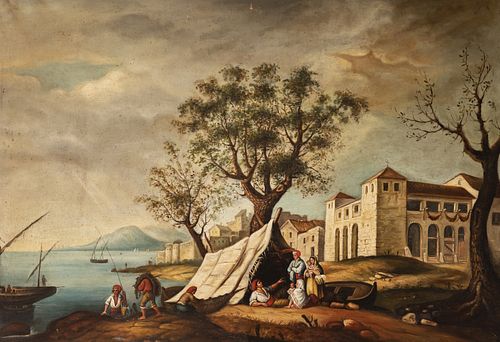Andalusian school of the mid-nineteenth century. Circle of ANDRÉS CORTÉS AGUILAR (Seville, 1812 - 1879). "View of port". Oil on canvas.
Lot 7
About Seller
Setdart Auction House
Carrer Aragó 346
Barcelona
Spain
Setdart Subastas was born in 2004 and is currently the first online art auction in Spain with solidity, prestige and reliability guaranteed by our more than 60,000 users. Setdart has a young, dynamic and enterprising team ready to successfully manage the purchase and sale of art works through custom...Read more
Estimate:
EUR€1,200 - EUR€1,500
$1,250 - $1,562.50
Absentee vs Live bid
Two ways to bid:
- Leave a max absentee bid and the platform will bid on your behalf up to your maximum bid during the live auction.
- Bid live during the auction and your bids will be submitted real-time to the auctioneer.
Bid Increments
| Price | Bid Increment |
|---|---|
| EUR€0 | EUR€10 |
| EUR€200 | EUR€25 |
| EUR€500 | EUR€50 |
| EUR€1,000 | EUR€100 |
| EUR€3,000 | EUR€200 |
| EUR€5,000 | EUR€500 |
| EUR€10,000 | EUR€1,000 |
| EUR€20,000 | EUR€2,000 |
| EUR€50,000 | EUR€5,000 |
About Auction
By Setdart Auction House
Nov 10, 2021
Set Reminder
2021-11-10 08:00:00
2021-11-10 08:00:00
America/New_York
Bidsquare
Bidsquare : 19th & 20th Century paintings and Decorative Arts
https://www.bidsquare.com/auctions/setdart-auction-house/19th-20th-century-paintings-and-decorative-arts-7800
Setdart Auction House sofia@setdart.com
Setdart Auction House sofia@setdart.com
- Lot Description
Andalusian school of the mid-nineteenth century. Circle of ANDRÉS CORTÉS AGUILAR (Seville, 1812 - 1879). "View of port". Oil on canvas. Period frame with live woodworm. Presents faults. Measurements: 96 x 138 cm; 112 x 155 cm (frame). The painter offers us in this work a port view captured in the mid-nineteenth century, from the banks of a river, possibly the Guadalquivir as it passes through some Andalusian city. The landscape, of ambitious composition, appears populated by popular characters in different attitudes. Due to its stylistic and morphological characteristics, the present work can be related to the circle of Andrés Cortés Aguilar, a famous 19th century Andalusian painter. Born to a painter father, Andrés Cortés was the author of a prolific and very personal work, although there is little precise information about his life. His father, Antonio Cortés, lived in France and had been a disciple of the landscape and animal painter Constantin Troyon, which undoubtedly must have marked from his first artistic steps, which he took together with his father, the preference of Andrés Cortés for landscapes with herds, a genre in which he would become one of the most outstanding specialists of his time, and which defines a good part of his production. He also stood out as a great landscape painter of Sevillian costumbrismo, with works in which he was especially influenced by the Dutch masters of the 17th century, something that was common among the Sevillian landscape painters of the time. But what finally determined his recognition in the art world was his friendship with his great protector, the Basque industrialist J. M. Ybarra y Gutiérrez, the future Count of Ybarra, who gave him numerous commissions. Cortés painted other Sevillian views of equally ambitious composition, although he was mainly famous for his rural landscapes with herds. He also painted some portraits, historical subjects and religious scenes, and was an interesting type painter, a facet of which "El tÃo Gamboa de Hinojos" (private collection) is a good example. Andrés Cortés is represented in the Museum of Fine Arts of Bilbao, the Carmen Thyssen-Bornemisza and Bellver collections, the Romantic Museum of Madrid, the old palace of the Marqués de la Vega-Inclán, the City Hall of Seville, the Carmen Thyssen Museum of Málaga and the Museum of Art and Culture of Granada, as well as in various private collections and parishes such as Santa MarÃa la Coronada in Cádiz and San Roque in Gibraltar.
- Shipping Info
-
In-house shipping available. Please inquire at admin@setdart.com.
-
- Buyer's Premium



 EUR
EUR CAD
CAD AUD
AUD GBP
GBP MXN
MXN HKD
HKD CNY
CNY MYR
MYR SEK
SEK SGD
SGD CHF
CHF THB
THB














